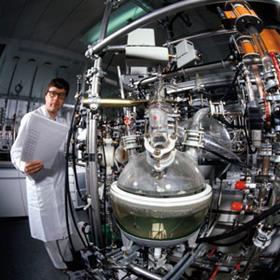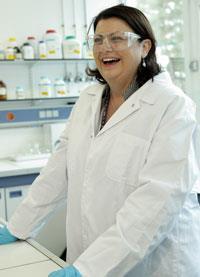The global economic crisis has made funding even harder to come by, but positive long-term trends provide some cause for optimism, as Maria Burke discovers
The global economic crisis has made funding even harder to come by, but positive long-term trends provide some cause for optimism, as Maria Burke discovers
The financial crisis has had a negative impact on investments in all industry sectors. But for a high-risk, capital-intensive sector, such as the biopharmaceutical industry, the financial crisis constitutes a serious threat to future development. The venture capital (VC) sector in Europe is increasingly reluctant to gamble on drug development projects in the current financial climate. Furthermore, VC firms have their own problems, including, for example, losing talent to the US. How then can European biotech companies continue to develop and retain their competitive edge?

The scale of the problem
The latest biotechnology sector report from accountancy firm Ernst & Young, released in April of this year, drew a realistic picture of the problems faced in Europe in 2009. It reported that, compared with 2008, VC raised in Europe fell 21 per cent to just €800 million (£693 million) - the lowest it has been since 2003. Meanwhile, revenues at European publicly listed biotechs grew only 8 per cent to €11.9 billion, well below the 17 per cent growth seen in 2008. On top of that, the value of mergers and acquisitions in Europe fell to €1.8 billion in 2009 from €3.1 billion in 2008.
However, the report also found that the combined net loss for biotechs in Europe fell from €913 million in 2008 to only €288 million in 2009, driven by cost cutting, loss of unprofitable companies and strong net income growth at some large European biotechs. Plus total funding for the European industry increased 48 per cent in 2009, to €2.9 billion.

’The European biotech community showed great fortitude in meeting the challenges of the economic downturn, with only a small reduction in the number of public companies,’ said Jürg Zürcher from Ernst & Young. ’With R&D funding essentially flat in 2009, European biotechs globally need to balance the need for cost cutting with ensuring they do not impair their ability to be drivers of innovation in the future.’
Globally, the story was very different: the report found that the industry delivered a strong financial performance in 2009, with the established biotech centres - the US, Europe, Canada and Australia - together reaching profitability for the first time. But it noted that the gap between the ’haves’ and ’have nots’ continued to widen. For example, the US sector had its second best year for VC funding in a decade, while Europe had its worst, posing new challenges for emerging companies, faced with ever-higher hurdles to access the capital they need for research and development.
The challenge for Europe
The Ernst & Young report expands on results published in December 2009 by the Danish Technological Institute, which warned that the financial crisis was hitting research-intensive companies hardest. The Danish team, which surveyed 87 European biopharmaceutical firms for its report to the European Commission, concluded that the sector faced three problems: funding shortfalls left over from the financial crisis; difficulties generating VC funding due to the challenges facing the European VC industry; and difficulties generating non-VC funding arising from the high-risk profile of the sector.
The Danish report found that three quarters of firms surveyed said the financial crisis had made access to capital more difficult, especially via an initial public offering or VC. Early stage companies were finding it hard, but late stage companies were also struggling. More than 40 per cent of companies said they would need to raise capital within the next year to maintain their current activity level. If the funding situation continued to be critical, companies said they would probably postpone new R&D activities or reduce numbers of drug candidates. ’This may eventually have a negative impact on drug development activities in Europe, and - in a wider perspective - European innovation, economic growth and employment,’ the report concluded.
Historical funding

Although the recent economic crisis highlighted the problems, European biotech companies have been struggling over the past decade to raise funding, says Tom Saylor, chief executive of Arecor and chair of the small and medium enterprise (SME) platform at EuropaBio (the European Association for Bioindustries). ’While some companies are receiving funding, the traditional sources have become increasingly unable to provide for the needs of emerging biotech companies in Europe,’ he explains. ’Public markets, which are particularly important for companies in the later stages of developing new drugs, have been all but closed for biotech over the past decade. VC investment has been particularly hit by the current funding crisis.’
One of the luckier companies has been Pantec Biosolutions, a private Liechtenstein-based company developing transdermal drug delivery technologies. It announced in July that it had raised CHF20 million (£13 million) in two financing rounds. ’It was quite difficult to get to the right investors with the right conditions,’ says Christof Boehler, Pantec’s chief executive. ’It took a longer time than we had hoped. We have struggled for the past 18 months, but we were lucky that we had an existing strong research base to bridge the gap. We also implemented cost saving strategies and reduced speed on a few projects.’
Boehler believes the VC industry is changing dramatically, in particular, downsizing considerably. ’In future, I think private investors - entrepreneurs with a vision to invest in high-tech industries - will become more important.’ He says this is a good thing because private investors are not so driven by how soon they can leave with the money they have made.
Swedish company BioInvent International also managed to attract funding this year. It raised SEK150 million (£14 million) on the Swedish and Norwegian markets in February by issuing more shares. ’We have been quite lucky as we have had time to establish a product portfolio,’ says Cristina Glad, executive vice-president. ’But I’m aware that other companies have experienced real problems. Many Danish biotech companies have had to make drastic [job] cuts. In Sweden, companies have restructured and slowed down their activities to make their money last longer.’
Supply problems
The most important capital source for European biotech companies is VC, whether from VC funds or large pharmaceutical companies, and the supply is undergoing several changes, the Danish report found. One of the major changes was that venture capitalists are increasing their share of late stage investment, while their share of early stage investments has declined. Echoing Boehler’s comments, the report says that the early stage is increasingly dominated by three types: private investors, such as so-called business angels, who have high net worth and invest directly; public incubators, publicly funded facilities that build networks between academia, industry and investors; and state-backed investment funds.
The Danish report goes on to suggest that European VC funds spread themselves too thin, supporting too many companies with insufficient funding. A possible explanation is that the European VC industry is more fragmented than, for example, its US counterpart. In addition, funds in Europe manage 50 per cent less capital than those in the US, meaning they may be too small to ensure sufficient capital for follow-on investments or to develop the expertise needed to invest in the sector.
’Europe simply does not have the required number of active institutional investors for life sciences venture capital funds,’ says Mark English, spokesman for Máire Geoghegan Quinn, the European commissioner for research, innovation and science. ’In the biopharma and biotech sectors, there is a major gap in Europe between research funding and getting a project to market.’
For biotech companies looking for investment, the US has three advantages over Europe, Saylor comments. First, the integrated public and private capital markets: in Europe public and private capital markets are independent of each other. These provide risk capital at both early and later stages of product development. Second, investors are less risk averse. Third, for biotech products, there is just one market in the US but many national markets in Europe.
Against this background, the European Investment Fund (EIF) has taken a hand in boosting Europe’s VC industry. The EIF calls itself Europe’s leading developer of risk financing for innovation. It invests in VC and growth funds to enable them to reach the right size for implementing their investment strategy and usually focuses on supporting innovative technologies in SMEs. It is co-owned by the European Investment Bank, the EC and 29 financial institutions.

’In view of the strained fundraising climate, EIF is - for the time being - prepared to increase its relative stakes in selected new VC fund investments above the average stakes taken in the past,’ says Joélle Harvey of the EIF. ’In 2009 alone, despite a market in which the availability of private sector investment resources diminished significantly, EIF committed €733 million.’ This, he says, demonstrated its willingness to move against the natural business cycles.
The Mezzanine Facility for Growth, approved in April 2009, is a €1 billion fund for investment throughout Europe. Harvey explains: ’it provides alternative financing to support, for instance, shareholding reorganisation or expansion for more mature businesses and late-stage or expansion technology companies. Mezzanine funding can be tailored to meet the specific financing needs of these SMEs and is well adapted to long-term financing.’ By the end of 2009, the EIF had approved investment in seven mezzanine funds.
What else is the EU doing to help?
This autumn the EC will propose the flagship initiative Innovation Union, first announced in the Europe 2020 strategy. English explains: ’its aim is to boost innovation from ’research to retail’ and to speed up the development and deployment of key technologies.’ The EC will also produce a Communication in 2011 that will provide an agenda for developing the bio-economy and take over where the Life Sciences and Biotechnology strategy left off. This may include creating a European Biopharmaceutical Innovation Fund to increase availability and access to VC.
The EC’s innovation subgroup - a group of commissioners with interests in innovation - is committed to transforming research funding policy to deliver a single market for innovation, English continues. ’More generally, the changes in capital requirements and other banking regulations being discussed at G20 and EU level would make the financial system safer and, over time, improve banks’ lending capacity,’ he adds. ’And we should not be too pessimistic; despite the challenges, improved European growth prospects should boost the flow of bank lending.’
English points out that the EU already supports access to finance for SMEs through several tools, including the competitiveness and innovation programme and a risk-sharing finance facility. And the EU’s research framework programmes (FPs) have invested substantially in European biotech research.
FP7 has €6 billion allocated to cooperative health research for the period from 2007 to 2013. Out of this, about 14 per cent is expected to go to biotech-related health projects.
Commissioner Geoghegan Quinn has taken an important leadership role in improving the climate for SMEs and innovation in biotech, according to Saylor. ’Given the risk and capital-intensive nature of biotech, more effective use of existing funding programmes, such as FP7, can be crucial to providing capital to bridge the shortfall from other sources and advancing the innovation potential offered by SMEs,’ Saylor remarks.
EU programmes are an excellent way of getting early financing, agrees Glad. Companies can use funds to develop research projects ready for later-stage VC funding or alliances with pharma companies. BioInvent was involved with FP6. ’We took the initiative in our project, which gave us the freedom to structure it as we wanted and to make sure intellectual property was handled properly,’ says Glad. She urges companies not to be put off from applying for European funding: the system is less bureaucratic now, she says, with plenty of time between the call for applications and deadline.
A special relationship

The relationship between the biotech and pharmaceutical sectors is important to both sectors, especially in troubled economic times. Biotech enterprises often have only limited resources and may gain access to capital by selling or out-licensing drug candidates, or establishing alliances with pharma companies. On the other hand, research projects in the biotech sector constitute an opportunity for pharma companies to boost their pipelines with promising drug candidates.
There is a strong symbiotic relationship here, agrees Saylor. ’Many large pharmaceutical companies have recognised the relative strength of SMEs in developing innovative products and are aggressively cutting their own research activities in favour of increasingly outsourcing innovation.’
This relationship with big pharma has always been important for biotech companies, comments Glad. But it has changed over the years. ’It used to be that pharma looked for mature projects with little risk, but now their interest is broader and begins earlier in the process.’ BioInvent, which has agreements with Genentech and Roche, licensed out a project before it had even entered clinical trials. Glad continues: ’pharmaceutical companies have cut back on research activities but still need to fill their pipelines. They have recognised that biotech companies are more flexible and innovative.’
Some major pharmaceutical companies have established VC companies to bridge the funding gap. Boehringer Ingelheim, for example, announced in March this year that it would set up a €100 million fund - the Boehringer Ingelheim Venture Fund - mandated to invest beyond the current therapeutic area focus of the company.
Pantec’s Boehler believes the pharma industry will have to come up with more VC funds in future. ’In the past, they have let the VC industry take the risk of development into Phase II and then harvested the fruit.’
And for the future?
Generally, the future outlook for biotechs is gloomy. However, there’s no shortage of advice on how to tackle it.
Access to capital will remain difficult, according to Ernst & Young, with the biggest opportunities emerging from efficiency increases. It outlines five guiding principles for biotechs: broaden the search for capital and seize any funding opportunities; boost capital efficiency, for example, by prioritising pipeline assets; focus on reimbursement, not just marketing approval; collaborate creatively; and differentiate products and platforms to attract partners.
’Our biggest challenge for the coming years will be to ensure that the incentives to invest in biotech remain clear and strong,’ comments secretary general of EuropaBio Nathalie Moll. ’SMEs represent the engine that drives biotech innovation in the EU and we must help them to fulfil their potential. Biotech companies must be enabled, through the creation of a predictable, coherent and supportive regulatory environment, to continue finding solutions to some of society’s most important challenges.’
Maria Burke is a freelance science writer based in St Albans, UK






No comments yet